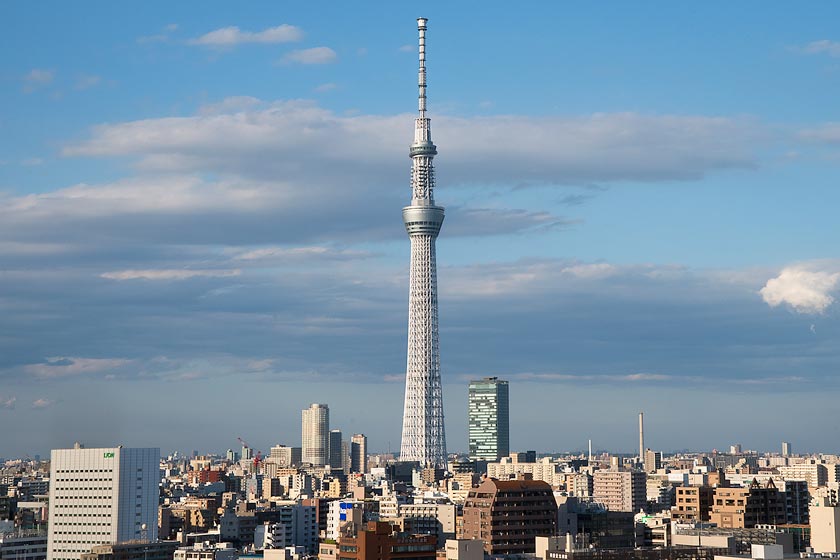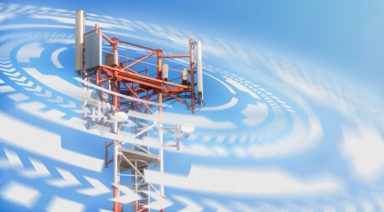Japan’s Space Elevator Expected to Be Built By 2050

In 1979, famed science fiction author, Arthur C. Clarke, wrote a book titled The Fountains of Paradise, in which a future society builds an elevator to space from a tiny island on the equator. Now, Clarke’s vision may soon come to fruition when a Japanese company begins work on its own space elevator.
What is a Space Elevator?
A space elevator is hypothetical for now, but Japanese construction giant, Obayashi Corporation, believes the necessary technology to build one could be ready in the next 10 to 12 years. The biggest hurdle at this point is developing a material strong enough to build cables 60,000 miles long and capable of transporting 100-ton cargo.
The elevator would essentially consist of a space station tethered between an anchor and a counterweight in Earth’s orbit. Dangling down from the station would be a series of cables made of carbon nanotubes – a real material developed 20 years ago that is stronger than steel by a factor of nearly 10. The only problem is that we haven’t quite figured out how to scale the technology. At the moment, we’ve only been able to create a few-centimeter-long stretch of them.
Once those tubes are scaled, which Obayashi believes will happen by 2030, an anchor would be built on Earth somewhere along the equator that would attach to the space station and a counterweight further up. The station would reside in what’s called Clarke orbit, or geostationary orbit, named after the sci-fi author himself. In this scenario, an object remains in orbit over a single point on the equator, an obvious necessity for a space elevator to be feasible.

Obayashi’s concept
The elevator cabin itself would ascend at about 120 miles per hour and carry a maximum capacity of about 30 people. For propulsion, it might be powered by a laser shot up from Earth that would supply it with the energy needed to climb the cables.
The trip would take about a week and function as a platform for scientific research, a launch point for space travel, and a mode of space tourism. The elevator could cut the cost of transporting materials into orbit by a factor of 100, which could propel space programs and colonization efforts at an astounding rate.
One man who has devoted his life to studying the viability of space elevators is Michael Lane, and he’s raised over $100,000 on Kickstarter to work on models and prototypes. Laine wants to first build a space elevator on the moon, because a weaker material could be used for the cables, like Kevlar.
On the moon there’s little gravity and no ice or wind, presenting ideal conditions for an elevator. Also the setup would only require roughly the strength of a strong man to hold the system in place. Laine’s idea proposes that rare earth elements could be harvested and brought back to earth, creating a booming space mining operation.
Is the Space Elevator Possible?
The Obayashi Corporation believes it can have the space elevator functioning by 2050 if carbon nanotubes become scalable by 2030. The company says that it holds competitions among university students to encourage them to study and advance the technology. Although over the past several years, advancements in AI like ARES (Autonomous Research System), allow scientists to let robots conduct, analyze and test hundreds of experiments autonomously, adding to the chance that nanotubes will be scaled within Obayashi’s timeline.
Obayashi is a massive construction and development firm in Tokyo that is responsible for a number of large scale engineering feats across the world. One structure designed by the company, the TOKYO SKYTREE, is the largest free-standing tower in the world, at just over 2,000 feet.

According to the company’s plan, there will be a series of anchors to counterbalance the elevator. The space station that would serve as the final destination would be situated at about 22,000 miles above Earth. Further out would be the anchor at an altitude of about 60,000 miles. Before the primary station there would be additional hubs at altitudes where one could experience the level of gravity on the moon and on Mars, which would be ideal for conducting experiments for future missions.
Not everyone believes that a space elevator will be built as easily as Obayashi does. Elon Musk has scoffed at the idea, saying that until someone builds a structure made of carbon nanotubes longer than a footbridge, he won’t consider the possibility of a space elevator. Musk also says he believes that until we have a carbon nanotube trans-oceanic bridge, say between LA and Tokyo, we shouldn’t be talking about building space elevators.
A trans-oceanic bridge seems rather silly though, considering we have the ability to fly across oceans in a much more efficient manner. Why would anyone want to spend days driving from LA to Tokyo when they could fly? Even bullet trains aren’t fast enough for a transoceanic bridge to be meaningful.
But no major technological feat has ever occurred without its detractors and naysayers who claim these visions to be impossible or impractical. Maybe Musk is right and rockets or alternative jet propulsion will reign supreme over space elevators, but Obayashi plans on continuing its lofty aspiration, with others following suit. Will Arthur C. Clarke’s vision one day come to be realized?
Stargates and Hidden Portals on Earth and in Space

In 2015, NASA admitted that the idea of Earth portals — areas on the planet that instantly teleport human beings from one place to the other — are a reality that they have been studying for quite some time.
One of NASA’s spacecraft, the THEMIS, and cluster probes from Europe have amassed enough observational data to confirm that a magnetic stargate portal exists in many locations.
Usually these are found where the faraway geomagnetic field bumps up against the passing solar wind. The result is a direct pathway between the Earth and the sun.
In March 2015, NASA launched its Magnetospheric Multiscale Mission (MMS) that, among other things, is tasked with studying these portals to gain a deeper understanding of them. Most of these are small with short lives, though others have been observed as gaping holes with sustained lifespans. Opening and closing numerous times during the day, magnetic forces mingle, allowing their crackling energy particles to flow between the Earth and the sun. These meeting points — called X-points by NASA — have been pinpointed by scientists using polar data.
The Bermuda Triangle
The Bermuda Triangle is probably the most famous stargate portal. Encompassing three vertices, the Bermuda Triangle — sometimes referred to as the Devil’s Triangle — is a large abyss that stretches between San Juan, Puerto Rico, Bermuda Island, and Miami, Florida. First noted in late 1950 or early 1951, the Bermuda Triangle was deemed to be a mysterious area in which huge military ships and planes were “lost” without any other plausible explanation forthcoming from the government or the military. In 1964, Vincent H. Gaddis argued that the Bermuda Triangle was the site of strange occurrences such as disappearing tanker ships and jets with the government being unwilling — or unable — to provide a reason or explanation.
The Philadelphia Experiment
The Philadelphia Experiment, also sometimes called Project Rainbow, grew out of the desire to cloak the U.S. Navy’s destroyer, USS Eldridge, so that enemy devices were not able to detect it. Built on concepts relative to stargate portals, the project relied on a technological application developed by well-known and respected scientific greats Nikola Tesla and Albert Einstein.
Testing started in 1943 and was successful to a large degree. In fact, some witnesses noted that they saw a green fog in the area where the massive ship once stood. Further experiments in late October resulted in the USS Eldridge vanishing from its shakedown cruise in the Bahamas. Simultaneously, sailors stationed 375 miles south at the Norfolk Naval Base in Norfolk, Virginia, reported the ship’s appearance for several minutes before it vanished.
Alfred Bielek, a former crew member on board the USS Eldridge, and Duncan Cameron, who would later work on the Montauk Project, jumped from the deck of the USS Eldridge when it was trapped in hyperspace and landed in the future.
Once they arrived at Camp Hero in 1983, they were tasked with returning to the USS Eldridge in order to destroy the equipment holding the ship in hyperspace. The pair did so successfully before leaping off the deck and materializing in the current year.





































